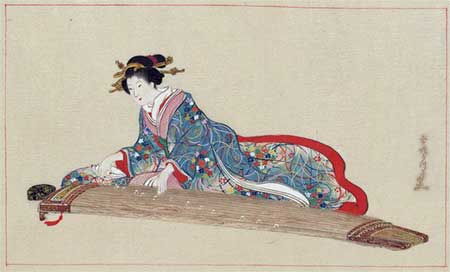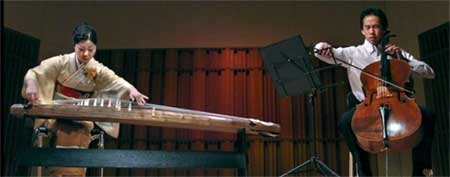Concert
Yoko Reikano Kimura, koto/shamisen/voice
Hikaru Tamaki, cello
Pierce Hall
New England Conservatory of Music
Symphony Hall Area
Boston, MA
Kitajima-kengyo, Akashi, for koto and voice
Takatomi Nobunaga, Possessed by Fox, shamisen and cello
Toshiro Mayuzumi, Bunraku for Solo Cello
Tadiao Sawai, Shou for solo shamisen
Marty Regan, Silence of the Moon, koto and cello

When I first heard about this concert, I wondered whether the sound might be a little thin with essentially two stringed instruments playing alone. I do love string duos – cello and violin, for example, but generally, am aware, when I do hear them, why more deeply orchestrated chamber forms like piano trio and string quartet are more popular.
It was, therefore, an unexpected pleasure to hear the tonal richness of this koto and cello duo and, as well, to experience the dramatic and penetrating sophistication of the playing of these two instrumentalists. To boot, the duo’s repertoire is a fascinating selection of mostly contemporary works that features the expressive strengths of both instruments.
Hiroki Tamaki, Dance of Darkness, for koto and cello
Apparently this piece was influenced by Arabian music. An assertive, passionate cello entry is punctuated by a koto frisson, and develops in a way that calls to mind Ernest Bloch’s piece for cello and orchestra, Schelomo (1915), inspired by the image of ancient Israel’s King Solomon. (How closely related are these different Middle Eastern motifs!) A beautiful combination of sounds evolves, with elongated cello and harpsichord-like plucks of the koto. Evocative unison runs are played with authority. The plaintive calls of cello against the staccato shimmers of the koto are a bit reminiscent of Shostakovitch, particularly in the energetic parts.
Kitajima-kengyo, Akashi, for koto and voice
Before embarking on this traditional piece, Kimura explains the different tunings required by each piece. As well, she notes that the whole collection from which the performed selection of pieces is taken runs twenty minutes. If I am not mistaken, she also explains that these songs are derived from The Tales of Genji, the Japanese classic about the lives of courtiers written in the 11th century by the noblewoman and lady-in-waiting Murasaki Shikibu. Elongated and seemingly somber, this piece evolves as a series of attenuated phrases forming a plaintive cry, filled with the sense of longing to return home and the feeling of rain dropping on autumn leaves. Kimura’s voice control is amazing, especially as she demonstrates the capacity to reach the lower registers.
Takatomi Nobunaga, Possessed by Fox, shamisen and cello
The shamisen is a smaller stringed instrument than the koto, a little more like a banjo in appearance, played with a large plectrum that does not look unlike a broad, plastic putty-knife. The performers explain the significance of the magically transformative significance of the fox in Japanese mythology which often exhibits the ways in which foxes possess or turn into people. The piece starts atmospherically with scrapings and runs, quite affecting. A lovely and varied series of sound effects produced by the shaking of the hand on the shamisen fingerboard erupts, followed by an interesting series of syncopations and echoes, again with a hovering flavor of Shostakovitch in the background.

Hikaru Tamaki (cello)
Toshiro Mayuzumi, Bunraku for Solo Cello
Tamaki explains that this postwar Japanese composer was the first, during the 1950s and 1960s, to blend traditional and contemporary music in interesting ways. One of his interests, for example, is imitating the sound of the shamisen of the cello. Here, the image of bunraku, or traditional Japanese puppet theatre, prevails. The piece starts with a series of assertive plucks, and develops in a way that is very reminiscent of Zoltán Kodály’s Sonata for Unaccompanied Cello (1915) with beautiful and emotive playing by Tamaki. The coordination of left and right hand plucking is striking, with nicely textured shaping of landscapes and some wonderfully jazzy, syncopated passages.
Tadiao Sawai, Shou for solo shamisen
Kimura explains that Sawai is a popular Japanese composer and a wonderful shamisen player. Apparently, the shamisen is 300 years old and, like the banjo, has qualities as both a stringed and percussive instrument. She explains that the three strings are silk, and very breakable, making any performer on the instrument somewhat nervous. The rest of the parts of this traditional Japanese instrument, she points out hunorously and ironically, includes cat skin from India and rosewood from Indonesia. The piece has strong suggestions of themes from popular Western music, reminding me in parts of the bolder sections from the score of the musical Les Misérables. It ends with a striking and dramatic snap.
Marty Regan, Silence of the Moon, koto and cello
Kimura observes in passing most interestingly, before this closing piece by a Western composer friend of the performers, that this style of vocalization, unlike the Western style which focuses, as she puts it, in the head, focuses in the belly. Apparently, this piece is influenced by shakuhachi, Japanese flute. A long, atmospheric entrance by the cello, subtly colored, is followed with echoes from the koto. Lovely unison pluckings, again with an atmospheric quality, are shaped by beautiful coordination of the koto and false harmonics on the cello.
The performers were available for conversation after the performance and exhibited, in personal interaction, the grace and charm they both demonstrated in their playing.
A delightful, interesting and musically compelling experience overall.
– BADMan
Leave a Reply